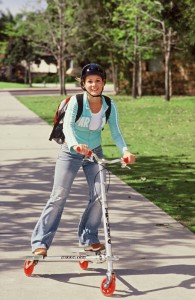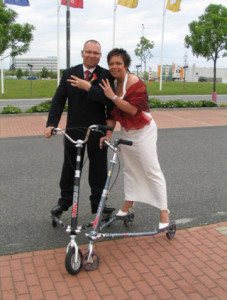 The trikke (pronounced “trike”) is essentially a scooter with two wheels at the rear instead of one. You don’t push your feet against the ground to go forward, however. You lean from side to side, similar to the way you’d propel yourself on skis. It takes a little practice, but it’s not hard to learn. If you watch the video at the end of this post, you can see how it’s done.
The trikke (pronounced “trike”) is essentially a scooter with two wheels at the rear instead of one. You don’t push your feet against the ground to go forward, however. You lean from side to side, similar to the way you’d propel yourself on skis. It takes a little practice, but it’s not hard to learn. If you watch the video at the end of this post, you can see how it’s done.
Fans of trikking claim that it’s great exercise. On a bike, you use your legs. They move the pedals, which drive a chain, which turns a wheel. On a trikke, you use your whole body to create forward motion. You can even alternate between using your upper body to tilt the handlebars from side to side, using your pelvis to sway the trikke from side to side, or using a combination of both. Riders claim it has the potential to use and tone all the muscles in the body.
What are the advantages of a trikke?
- Unlike a bike, the three wheels make it stable. It won’t fall over when you slow down.
- Unlike jogging, it’s non-impact, so it’s easy on the joints.
- As I just mentioned, it exercises more of both the upper and lower body than a bike.
- It burns more calories in an hour than light jogging (520 vs. 350).
- You can fold it up and put it in the back of your locked car.
- You can get in shape for skiing when there’s no snow.
What are the disadvantages?
- You need about the width of a sidewalk to propel yourself forwards. I wouldn’t recommend trikking to work on a busy street.
- A flat, smooth surface for riding is best. You can trikke uphill, but it takes a lot of effort.
- Trikkes have an image problem. They look like scooters with training wheels.
- Jennifer Anniston and Brad Pitt were into trikking and look what happened to them (just kidding).
Does the trikke have an image problem?
 I live in sunny California where I see lots of people outdoors being athletic. I’ve never seen a trikke. It appears the trikke is a fad – or possibly a sport — still waiting to happen. There’s some distance to be covered before the trikke competes with the bike.
I live in sunny California where I see lots of people outdoors being athletic. I’ve never seen a trikke. It appears the trikke is a fad – or possibly a sport — still waiting to happen. There’s some distance to be covered before the trikke competes with the bike.
Sales figures confirm this. Although sales in the US rose from 2,500 in 2002 to over 60,000 in 2008, there were 18.5 million bicycles sold in 2008.
Is this an image problem? Is the trikke too safe to deliver an adrenaline rush? If it’s something women and girls would do, does that mean it’s not exciting enough for boys and men? Do boys prefer activities that exclude girls, which is what seems to have happened with skateboarding?
Despite the handlebars, a trikke is actually more like a skateboard than a bicycle. If you search for images of skateboarding, what you find almost exclusively are photos of boys and young men executing risky action moves. Girls are not welcome. If you search for images of trikkes, you can also find plenty of daring action shots. But you also find many more images of women, such as the woman in the photo – a Czech couple who rode to their wedding on trikkes.
Why don’t girls use skateboards?
I’ve always wondered: Why wouldn’t girls use skateboards as a means of transportation between point A and point B? I have seen all of two girls with skateboards in my life.
I found an interesting article on the subject of skateboarding and gender relations. When boys are asked why there aren’t more skateboarding girls, they say it’s that girls are afraid of pain. They consider girl skaters sexually promiscuous, unskilled and afraid to take risks. Girls are outsiders to the male culture of skateboarding.
When asked if girl skaters are fairly represented in skate magazines, one girl skater replied: “They have all of those girls in bikinis. They are bare-naked but holding a skateboard. It isn’t for girls’ skating it is for guys.”
The authors of the article, who include both men and women, conclude that male dominance of skateboarding is linked to assumptions about qualities of the male body. And that masculine patterns of behavior are not easily changed, but should be. Here is their rather academically dense way of putting it:
[T]he symbolic violence directed towards women in street skateboarding is not easily resisted or transformed. We suggest that challenges to masculine domination can only take place through the erosion of the symbolic order through which male-associated qualities of the body remain ascendant. Power that is linked with the legitimation of the masculine habitus [patterns of thought, behavior, and taste] can only be shifted when existing practices and perceptions are simultaneously disrupted; only then will the symbolic capital that is integrally associated with masculinity come to be seen as feminine as well.
The biologist Ruth Hubbard once said that if a society
puts half its children in short skirts and warns them not to move in ways that reveal their panties, while putting the other half in jeans and overalls and encourages them to climb trees … [t]heir muscles will be different.
Women and girls don’t have to wear skirts anymore, but that change has happened only within my lifetime. Maybe if more boys and girls and men and women took to riding trikkes, we could disrupt the perception of bodily differences between male and female and take a step towards a culture of gender equality.
Sources:
Image sources: Trikke Tampa, 3CV World Sports Federation
(Hover over book titles for more info. Links will open in a separate window or tab.)
Lenny Bernstein, Three Wheels, an Infomercial and an Offbeat Way to Lose a Few Pounds, Washington Post, July 21, 2009
Matthew Atencio, Becky Beal, Charlene Wilson, The distinction of risk: urban skateboarding, street habitus and the construction of hierarchical gender relations, Qualitative Research in Sport and Exercise, Volume 1, Issue 1 March 2009, pages 3 – 20
Ruth Hubbard, “The Political Nature of ‘Human Nature,” Theoretical Perspectives on Sexual Difference


Sorry, comments are closed for this post.